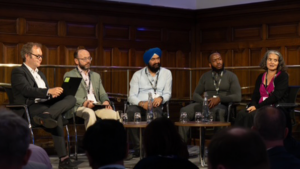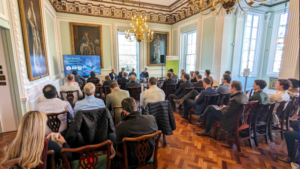
How mission-led teams can reduce waste in digital public services
Recently, I wrote a response to the Autumn Budget statement that covered ways to root out waste in the development of digital public services. I believe this approach will be key to driving new efficiencies while achieving better outcomes for the people of the UK.
In this post, I expand on this topic by talking about how digital consultancies can help public sector departments root out more waste by organising themselves into mission-led teams.
Our approach at Zaizi
At Zaizi, we have rejected a traditional hierarchical organisational structure in favour of a team of teams approach. Each team within that structure is focused on meeting the needs of a related set of public sector customers. These are grouped into distinct areas like defence, healthcare and the more operational departments like the Ministry of Justice or the Home Office.
Essentially, this means we have mission-based ‘clubs’ made up of a cross-functional group of people such as designers, user researchers, solution architects and engineers. They all have a deep understanding of the client’s organisational needs and are able to best balance it with the citizen needs to deliver great services for all. This makes those people very engaged and focused. They know what they are trying to achieve. They know what’s the most valuable thing to deliver. And, they know how they can make an impact.
Overarching this, we have a company-wide mission that is making the UK the best place to live and work. Having this enables our teams to make checks on what they’re doing – their sub-missions, if you like – and ensure we build digital public services that meet that goal and solve the real problem.
This approach benefits our public sector customers in a number of key ways – particularly those that are operating under new budget constraints and need to make the most out of every penny they spend.
We help our customers establish what success really looks like
Each of our teams is laser-focused on prioritising outcomes that meet the needs of the community. That means we very rarely take a brief and deliver it precisely as requested. We always start work on a project by asking ourselves and our customers several important questions. What is the real mission and outcome we want to achieve? How will the outcome help us to make the UK a better place to live and work? What would success look like? What would great look like: for our clients, for us – and most importantly the people the service is for?
By doing this we make sure we have a clear mission for each project. You can read more about how this helps to empower and motivate our teams here. We also have a much better chance of building the right solution that solves the actual problem. Projects that don’t work this way, on the other hand, risk going back to square one and running over budget.

Our mission-led teams know when to stop
Of course, I can’t claim that there are never going to be bumps in the road. That is not the way an iterative, agile process works when you’re building a digital service.
For example, after further user research we may find that we are going down the wrong path. With their mission clear in their minds, our teams feel empowered to let our customers know when it is right to stop a stream of work before more budget is wasted. We are trying to eliminate the possibility of building a service just for the sake of it. A mission-led team will never deliver a project in the wrong way simply because it has a statement of work.
Conversely, a mission-led team will not stop just because something is “out-of-scope” or not covered by the budget.
We suggest alternative approaches when they are more cost-effective
The mission-led team approach also enables us to make recommendations to our customers that surprise them. And save them money.
An example: The team recently worked with a client who had identified a security vulnerability in a critical business application. They requested we implement a like-for-like solution.
The team used a mission approach to understand the user’s goals and identify and prioritise the potential barriers, including the security concern. Through this research, the team discovered that the current system was bloated and inefficient.
We implemented a low-cost and lightweight solution, along with process and business changes, to not only address the security concern but also improve the user experience. This led to significant efficiencies.
Staying focused on our mission as a team meant we found a better and more cost-effective way of meeting the client’s desired outcome.
READ: How to design the best service design team for digital public services
My job as a leader of mission-led teams
Our mission-led teams approach enables us to provide greater clarity about our work and objectives. It also gives our teams autonomy that encourages diverse thinking and creativity.
My job, along with the rest of my leadership team, is to provide coaching, mentoring and support that the teams need to flourish in that environment and achieve their objectives.
My job is also to set the vision, our unifying purpose and mission, and ensure that we have the right company culture that enables everyone within our teams to think freely and do their best work.
Our mission-led structure has provided a significant boost to that culture in its own right. It has helped us to give people more purpose, drive improved outcomes and increase employee engagement.
Just as importantly, it is enabling us to help the public sector make critical savings in time and budget.
If you’d like to hear more – please get in touch.
-

Digitisation and legacy modernisation: Setting the foundations for government AI
-

The great legacy escape: Ditch the spreadsheets, drop the paper
-

The great legacy escape: How outdated systems and processes still hold government back
-

GDS’s research into AI in government – and how to deliver real value
-

From ScanApp to Lego demos — What you need to know about Security & Policing 2025
-

Truth, trust and transformation — 4 key takeaways from Zaizi’s AI in government event
